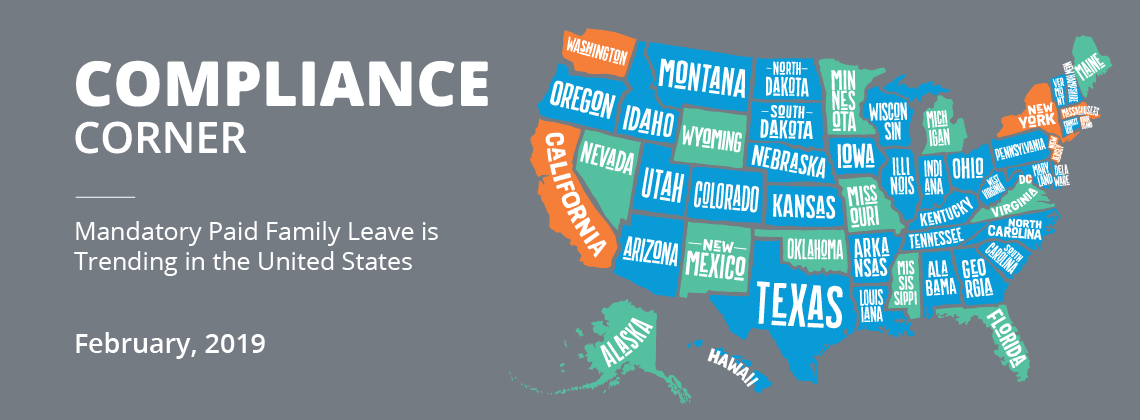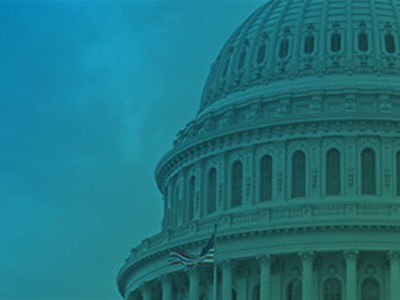Mandatory Paid Family Leave is Trending in the United States


Paul Kramer
Director of Compliance
Most workplace leave laws in the United States do not require employees to be paid while on leave. A growing number of states, however, are passing legislation mandating that employers provide paid family leave to workers. These laws place heavy burdens on employers, especially multi-state companies, because the terms and benefits of these laws vary from state to state. Below is a list of jurisdictions requiring, or who soon will require, paid family leave for employees:
California
Paid family leave in California is a state-sponsored insurance program covering employers of all sizes. Although this program does not create a leave of absence right for employees, it provides partial wage replacement for up to 6 weeks in any 12-month period while the worker is absent to care for a seriously ill or injured family member or to bond with a minor child within one year of birth, adoption, or foster care placement.
New Jersey
The New Jersey Paid Family Leave Act grants eligible employees up to six weeks of paid leave benefits in any 12-month period to bond with a newborn child (including a surrogate child) or a newly adopted/foster child within 12 months of birth or placement, or to care for a covered family member suffering from a serious health condition.
Rhode Island
As part of the state’s Temporary Caregiver Insurance Program, most employees in Rhode Island can take up to four weeks paid time off to care for a newborn or newly placed child, or to care for a seriously ill family member.
Digitalize Compliance Processes to Reduce Risk
Learn more effective ways to demonstrate compliance with the complex matrix of labor laws, while also keeping costs down and reducing risks.
New York
As part of its disability law, the state of New York requires employers to obtain insurance covering paid family leave benefits, which began being phased in on January 1, 2018. The program currently provides up to 10 weeks of paid leave to care for a family member with a serious health condition, to bond with a new child within the first 12 months after birth or placement, or to assist with family situations arising when a family member is called to covered active military duty.
Washington
Paid family and medical leave in the state of Washington is an insurance program funded through premiums paid by employers and workers in the form of paycheck withholdings. Washington workers will be able to use paid family and medical leave benefits beginning in 2020. These benefits will generally allow eligible employees up to 12 weeks of paid leave per year to care for themselves or a family member relating to an illness or medical event, to care and bond with a child after birth or placement, or for certain military events. For combined family and medical leave the total leave an employee can take in a year is 16 weeks, or 18 weeks if the leave includes a pregnancy-related complication.

Massachusetts
Starting in 2021 eligible employees may take paid leave for their own serious health condition, to care for a family member with a serious health condition, to bond with a newborn or newly placed child, for a qualifying exigency arising out of a family member’s military duty, and to care for a family member with a serious injury or illness incurred or aggravated in the line of covered military duty. The amount of leave will range from 12 to 26 weeks depending on the reason for the leave.
District of Columbia
Beginning July 1, 2021, the District of Columbia Paid Leave Act provides covered employees with up to eight weeks of parental leave to bond with a new child, six weeks of family leave to care for a family member with a serious health condition, and two weeks of medical leave to care for their own serious health condition.
Each paid family leave law is different.
Variables in these laws include which family members are covered; the length of the leave; the amount of pay employees receive; how the law functions with other state and federal leave regulations; the size and type of employer covered (e.g. private and/or public); and how the program is funded. And since other states are considering bills to provide paid family leave to workers, it is important for employers keep an eye on any additional time-off requirements that may be coming in the future.
More Awesome Content!
Embedding an ‘Eyes Wide Open’ Mindset Into HR Technology Selection
Gartner guides teams responsible for deciding on their organization’s next HR technology investment to set themselves up for success.
5 Workforce Management Secrets to Thrive in 2021 and Beyond
Download this eBook to learn the 5 secrets that will help your organization shift from surviving to thriving now and in the future and learn how the right workforce management solution can empower your initiatives.
VISION 2024: Ignite Conference—Day 1 Recap
Day 1 of VISION 2024: Ignite, our premier modern workforce management event, was full of enlightening sessions and engaging roundtables.




